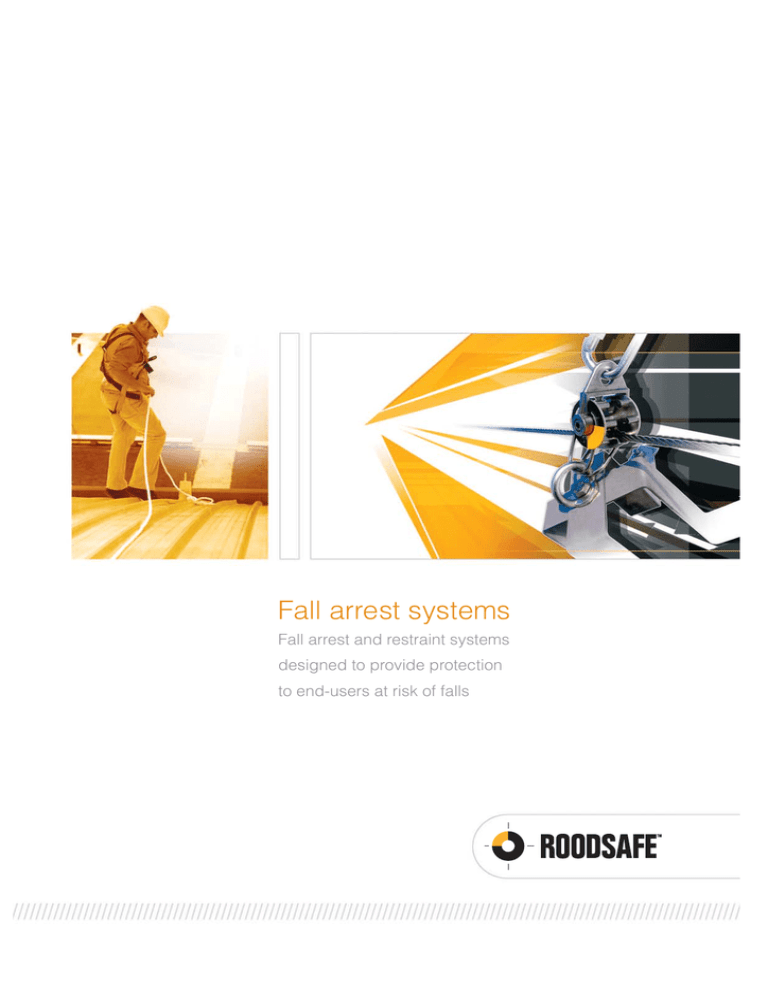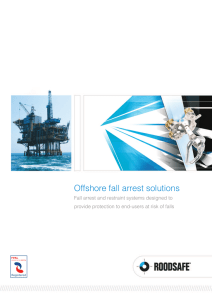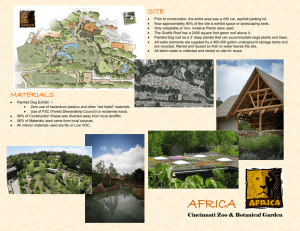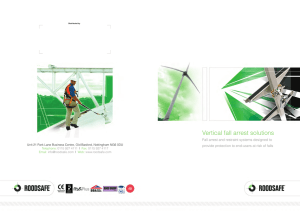Fall arrest systems
advertisement

Fall arrest systems Fall arrest and restraint systems designed to provide protection to end-users at risk of falls About Roodsafe Roodsafe was founded in 2000 and entered the Height Safety market with ladder restraint anchors, this product was geared to the domestic market. Roodsafe is acknowledged as the first company to successfully develop a removable ladder restraint system for the domestic market. Following the success of this product, in 2002 Roodsafe launched a commercial Fall Arrest/Fall Restraint system which is an engineered cable based system. This product is a market leader and is supported by a global distribution network. Over the last few years Roodsafe has added a number of further height safety products to its range including, Eyebolts, Vertical Cable Fall Arrest Systems, Ladder Restraint Systems, PPE Harnesses, Handrails, Training Courses etc. This is to meet the growing change in the market place driven by legislation and the new 2005 "Working at Height" regulations. In 2008 Roodsafe offered another innovative product to the market place – UPVC walkways, which are manufactured to meet the current legislation and are aesthetically pleasing to the eye. Roodsafe offer a design and specification service to support clients, distributors, architects and contractors. 2 System Choices Choices Fall Arrest System The design principle will protect end-users from serious injury, as it greatly reduces the effects of a fall. The enduser can reach a point where a fall can occur. Fall Arrest To allow this design principle to function correctly, a minimum fall clearance distance of 6m is required. This is needed to incorporate shock absorbing lanyard deployment and cable deflection, along with size (height) of end-users. A correctly designed system will arrest an end-user in the event of a fall (after 2m) preventing the end-user from hitting the deck. As indicated, ridge systems are installed to the ridge line of a roof. They can be installed slightly off centre (to the left or right) to allow for skylights, chimneys etc. Ridge systems do not run to the end of the building. They run on either side and should stop 2m from each edge of the roof end. Due to this design principle a pendulum swing hazard occurs. To counter this, 4No single point anchors (anti-pendulum posts) are required to be installed (1No in each corner) thus alleviating this hazard with the correct use of the PPE supplied. Fall Restraint System This design principle stops the end-user from reaching any position where a fall can occur, still providing full and unrestricted access to all areas of the roof as required (gutters, fans, roof lights etc.) and is the recommended choice of system. Fall Restraint The correct use of Personal Protection Equipment (PPE) i.e. Harnesses, Lanyards etc., is critical to this design principle working correctly. Loads exerted on restraintonly systems are significantly less than those required on fall arrest systems. Systems fitted to the perimeter of a roof are better for wider roofs, and are easier for end-users to operate. Perimeter systems tend to be no less than 2m from the edge of the roof and use a 2m shock absorbing lanyard, allowing adequate access to the roof edge tasks (gutters etc.). 3 Roodsafe Pyramid Post Roodsafe have developed a state of the art deflective force post which offers a complete fall protection solution to all roof types, Roodsafe have worked very closely with major roofing manufacturers to tailor fixings that allow a quick and speedy installation. Benefits of Deflective Force Technology: • Post can be fixed to the outer skin of any roof down to 0.5mm • Simplicity of installation • System design not restricted to the superstructure of the build envelope • Will work on inclines of up to 15° • Post deflection limits the loads to 10kn when used in anger Shock Absorber Assembly Bottom Pillar Base Plate simplicity 4 Pyramid Post Pyramid Post 5 Guardrail Guardrail Guardrail Roodsafe have developed their guardrail system even further. As well as the improved weight, is the arrival of the newly designed moulded foot. This design sets it apart from the traditional scaffold look of other systems. With its sleek, unique design and colour co-ordinated advanced features the Roodsafe Guardrail System continues to lead the market in design and innovation of guardrail systems. • The manufacturing procedures are unique as Roodsafe Guardrail Systems can be produced identically in galvanized, aluminium and stainless steel 304 or 316. • Any of the above materials can then be powder coated to any RAL colour, if required. • All fixings on the Roodsafe guardrail are stainless steel, offering unrivalled weather protection. • The telescopic uprights allow adjustment for the rise and fall of the roof. • Free standing ends, complete with D ends, and wall fixing ends are offered to meet your requirements. 6 UPVC Walkway Walkway UPVC Walkway The UPVC walkway clips directly onto roofs without damaging the roof, this also creates a demarcation route for end-users and has the advantage of being anti slip in accordance with BS 7976. Walkways systems enable safe access to all areas of the roof, designed in conjunction with a Roodsafe cable based height safety system, a completely safe working at height environment is created, even on a barrel roof in the wet. The component design of the walkway enables any width to be specified. Bearers are available to suit any roof profile. Fixings (if required) are manufactured in-house, they are self sealing and adaptable to any profile. 7 Vertical Solutions Vertical Solutions Vertical Height Safety Solutions The Rood V range offers a comprehensive engineered safe working solution for high risk environments. Risk Environments • Masts • Wind Turbines • Towers • Fixed Ladders • Cranes • • • • • Pylons Silos Bridges Chimney Stacks Offshore Solutions Rood V- Vertical Rail System EN 353/1 Rood VH- Horizontal Rail System EN 795 Rood VL- Vertical Rail Ladder System EN 353/1. Materials All Rood V Systems are aluminium, anodised (AIMg Si0.5 for marine use) providing maximum corrosion resistance. Versatility The Rood V Systems can accommodate up to 6 end-users, and can move from the vertical plane to horizontal without the need to change the travelling device (Glider V). European Wind Energy Association Roodsafe is a key member of EWEA and offers advanced height safety support for wind turbines. 8 Glider V Glider V Glider V A guided Glider V Fall Arrest Traveller, which mounts to a rigid anchorage rail system, the traveller allows a safe and controlled means of access for end-users. The Glider V Traveller can move directly from the vertical plane to the horizontal, thus providing a true continuous height safety solution, as there is no requirement to disconnect and reconnect the travelling device. 9 Rood V Rood V Fall Prevention Solutions (Rood V) The inherent strength and flexibility of a rail fallprevention system when compared to a cable based system makes it the ideal solution for offshore applications. The RV ladder has a built-in rail fallprevention system. This custom rail system can be designed and installed to follow the, often complex, contours of an offshore structure and will allow free traversing of the systems, going from the vertical to the horizontal plane, without the need to change travelling devices. This system can accommodate up to six end-users. The quality of materials used in our rail systems is proven, both durable and reliable, and will accommodate the worst climatic and environmental conditions that are experienced by the offshore industries. A fall-prevention rail system is also available that can be retro-fitted to existing towers and ladders. 10 Current Legislation Legislation CDM Regulations The Construction Design and Management Regulations (CDM) were introduced in 1994 to provide worker safety. CDM regulations require designers, contractors, employers, planning supervisors, clients to be jointly responsible for workers safety in all construction aspects, starting with demolishing, build, maintenance. 2002 (ACOP) a revised code of practise was introduced with additional requirements for clients and designers: Designers Full co-operation with planning supervisors, contractors to meet with Health & Safety requirements. Clients Have a responsibility to ensure the competence of designers, contractors and planning supervisors. HSE Code of Practise This identifies the requirement of the employer to ensure that any employee required to work at height must be suitably protected from any fall hazard. Working at Height Regulations In 2005/06 falls from height accounted for 46 fatal accidents at work and around 3350 major injuries. They remain the single biggest cause of workplace deaths and one of the main causes of major injury. The Work at Height Regulations are written for employers, the self employed and anyone who works at height. It tells what you need to do to comply with the Work at Height Regulations 2005, as amended by the Work at Height (Amendment) Regulations 2007. The regulations apply to all work at height where there is a risk of a fall liable to cause personal injury. Working at Height Regulations 2005 The key issues for rooftop maintenance are summarised as follows: The ‘duty-holder’ is responsible for minimising risk utilising the methodology stipulated in the ‘Hierarchy of Fall Protection’. The risk assessment and the action taken should be proportionate to the harm that could occur. Working at height is defined as ‘all work activities where there is a need to control a risk of falling a distance liable to cause personal injury’. This means that if there is a chance of a fall of any distance, the duty-holder must show that everything has been done to minimise the risk. The duty-holder must make sure the equipment specified is suitable for the particular use envisaged. It is critical to identify the difference between fall arrest and fall restraint. Inspection and maintenance are required to ensure that equipment is safe to use. The maintenance schedule will depend on the equipment, the conditions in which it is used and the manufacturers’ instructions. The following legislation should be taken into account when addressing the issue if working at height. Health & Safety at Work etc. Act 1974 This is an “Enabling Act” which imposes a duty of care on everyone at work related to their roles. This includes employers, employees, owners, occupiers, designers, suppliers, manufacturers and the self employed. Section 2 concerns the main duty of employers to ensure the health, safety and welfare at work of the employees by providing a written health and safety policy; safe plant and system of work and to provide information, training and supervision. Sections 3 - 5 detail an employer’s duty to ensure that people not in their employment are not exposed to risks to their health and safety. There is also a general provision for monitoring both employees and persons not in their employment to ensure compliance through method statements, risk assessments and general health and safety policies for completing a specific activity. This includes contractors working on their premises. Section 37 covers the personal liability of Directors. If an offence is committed by a corporate body or can be attributed to the neglect of a director or other senior officer of that corporate body, both the corporate body and the person are liable to prosecution. 11






